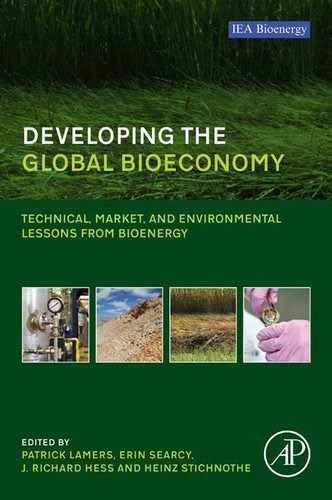List of Figures
| Figure 1.1 | Overview of the bioeconomy as understood within the context of this work. | 3 |
| Figure 1.2 | Bioeconomy strategies across IEA Bioenergy Implementing Agreement (IA) member countries as of September 2014. | 4 |
| Figure 2.1 | Overview of conversion technologies for biomass. | 14 |
| Figure 2.2 | Activities of some commercial mixtures of enzymes normalized to the activity of the latest CTEC3. | 24 |
| Figure 2.3 | Chemicals and advanced fuels that can be produced from bioethanol using a variety of chemical methods. | 25 |
| Figure 2.4 | Promising chemicals from glycerol. | 30 |
| Figure 2.5 | Basic process scheme of fast pyrolysis and additional process options. | 31 |
| Figure 2.6 | Variation of products from Aspen Poplar with temperature. | 33 |
| Figure 2.7 | Principal pathways for bio-oil applications. | 36 |
| Figure 3.1 | Model for cost calculation of biobased products. | 44 |
| Figure 3.2 | Production costs of ethanol from cellulosic feedstock. | 50 |
| Figure 3.3 | Production and feedstock costs for bio-oil from wood chips. | 52 |
| Figure 3.4 | Process flow chart of the bioliq process. | 56 |
| Figure 3.5 | Industrial-scale integrated bio-oil plant in Joensuu, Finland. | 56 |
| Figure 4.1 | Key issues in four areas of sustainability. | 72 |
| Figure 4.2 | Value chain of biofuels and fossil fuels. | 74 |
| Figure 4.3 | Lifecycle stages of products derived from fossil resources (in black boxes) and from biomass (in gray boxes). | 80 |
| Figure 5.1 | Global distribution of key solid biomass demand (solid, circle harbors) and supply regions (shaded, starred harbors) with respective harbors. | 93 |
| Figure 5.2 | Comparison of short-term biomass-based electricity production costs against current average national electricity production costs in South Africa and Netherlands. | 101 |
| Figure 5.3 | Comparison of long-term biomass-based electricity production costs against projected national electricity production costs in the Netherlands and electricity tariffs in South Africa. | 102 |
| Figure 5.4 | Cost–supply curve for corn and wheat residues delivered to the conversion plant in central South Africa. The dashed vertical lines indicate available crop residues below $5/GJ−1 delivery costs. | 107 |
| Figure 6.1 | Development of international biofuels trade 2004–11. | 119 |
| Figure 6.2 | Monthly US ethanol trade with Brazil and other countries between 2011 and 2013. | 121 |
| Figure 6.3 | Fixteri FX 15 whole tree bundling supply system. | 127 |
| Figure 8.1 | Schematic design of select operations in the conventional feedstock supply system. | 170 |
| Figure 8.2 | Schematic design of a vertically integrated advanced feedstock supply system concept. | 171 |
| Figure 8.3 | Modular depot concept illustrated for multiple biomass input streams and market options for merchandisable feedstock intermediates. | 171 |
| Figure 8.4 | Biorefinery and depot locations within a sourcing area (27 miles, dotted line; 500 miles wider circle) in two different years with varying drought patterns. | 180 |
..................Content has been hidden....................
You can't read the all page of ebook, please click here login for view all page.
